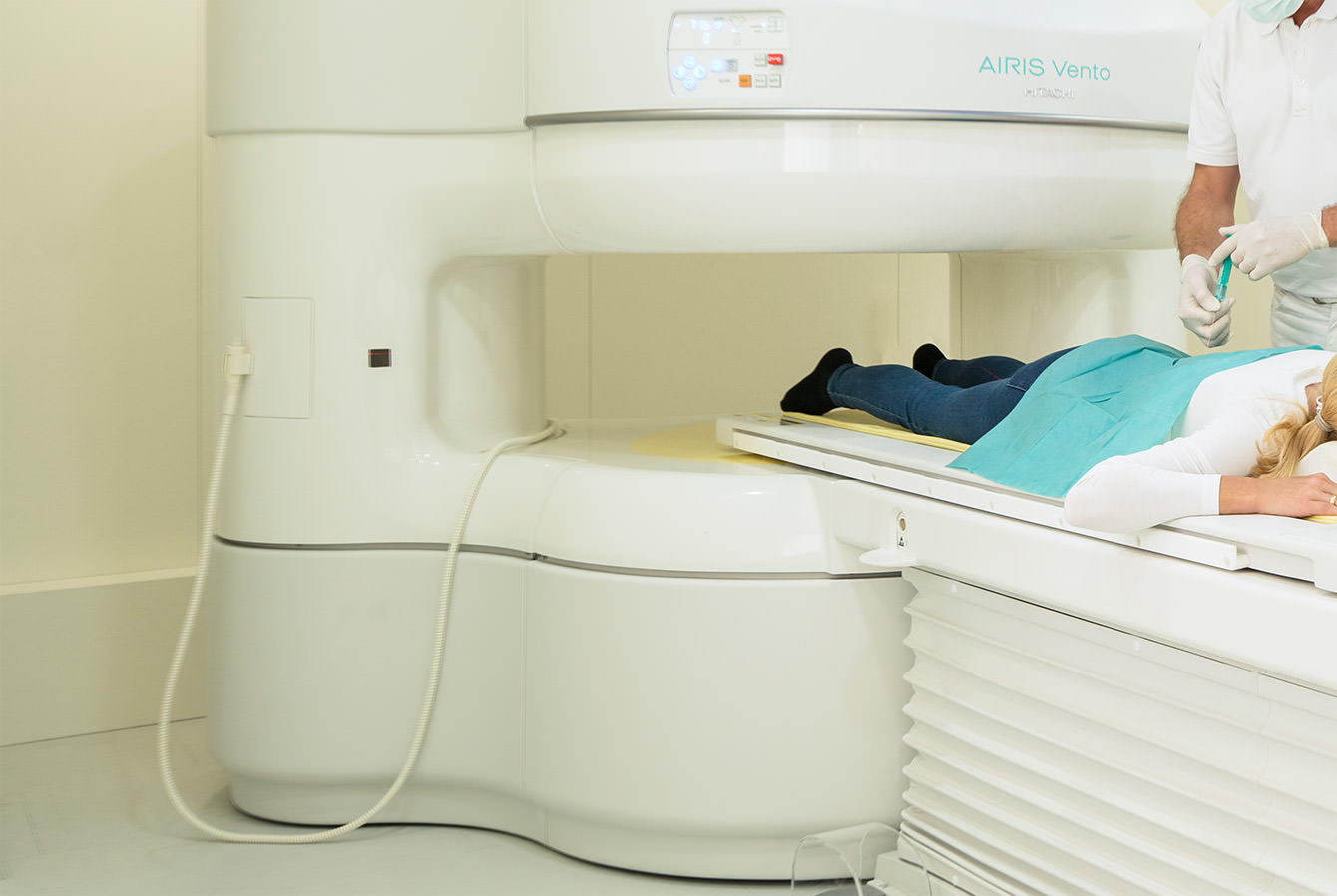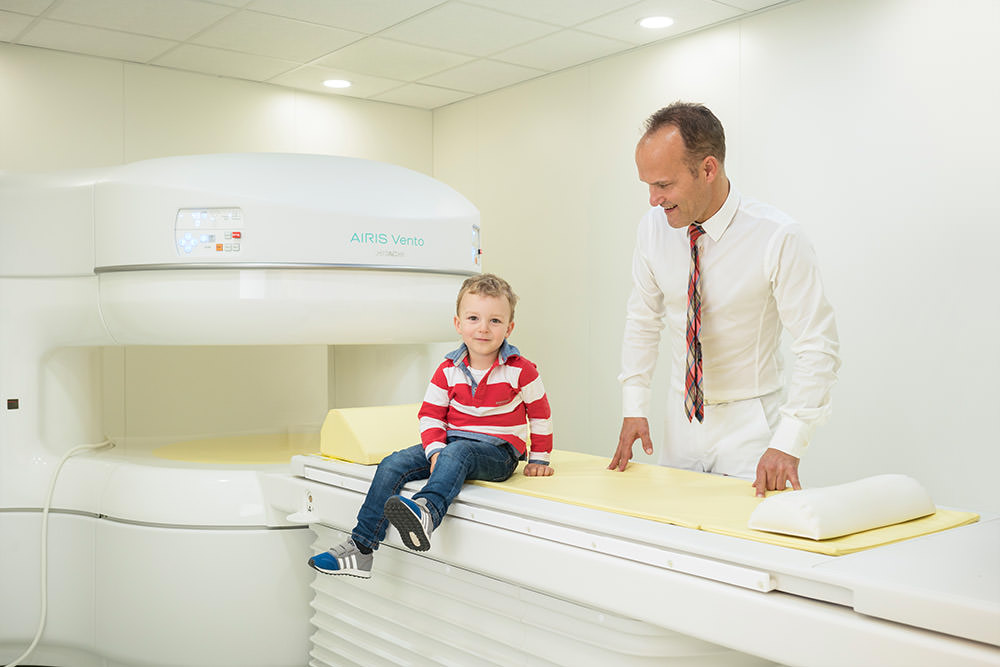The possibilities for therapy in an open MRI are numerous, allowing radiation-free and precisely accurate treatment, such as periradicular therapies (PRT) or administering healing promoting “Platelet-Rich Plasma” (PRP). In addition to that, at DSD, all OZD therapeutic measures are accessible without restrictions.
Overview
Chronic episodes of pain affecting the musculoskeletal system are often encountered and need to be met by targeted treatments from pain management specialists.
Various diagnostic systems are used, depending on the root cause of the pain. For this reason, we at DSD offer all of the leading procedures that are capable of providing the most advanced, high-precision diagnoses of the musculoskeletal system. Alongside conventional examination using ultrasound and X-rays, we can also offer access to one of the most modern open MRI scanners in Europe. This high-end machine enables us to offer our patients an entirely new range of diagnostic options and resulting types of treatment. Our comprehensive analysis of the causes of pain also includes a number of other diagnostic options, such as…
- Gait analysis systems
- Bone densitometry (DXA method)
- Muscle function analysis
- Three-dimensional static measurement of spinal column and pelvis
By partnering with Darmstadt Orthopaedic Centre (OZD), all of the above can be carried out under one roof: this avoids inconvenient and time-consuming referrals for medical exams and extra appointments to discuss results – all of which leads to greater patient comfort, more accurate diagnoses and a faster start to treatment.
Patients with acute sports injuries now have access to a full range of diagnostic options under one roof and on the same day, so as to ensure the fastest possible access to the necessary treatment options.
Dr Marc Dehos, DSD
Conservative pain management
The treatment options available from the German Pain Centre Darmstadt are carried out by doctors who have gained a wealth of experience during many years of being involved in managing pain affecting the musculoskeletal system. An interdisciplinary team of experts with a range of individual specialisms and therapeutic expertise is on hand to ensure that each patient receives a treatment plan tailored to their individual needs.
We offer advanced, high-quality treatment options to ensure your well-being.
Dr Thomas Saltzer, DSD
Complementing the familiar conservative options for pain management – which include analgesic therapy according to the WHO pain ladder, the use of biphasic TENS stimulation, neural therapy, cortisone injections to the joints, trigger point treatment, acupuncture, chiropractic manipulations of the spine, botulinum toxin injections, as well as various taping, bandaging and plaster treatments – the German Pain Centre Darmstadt now also offers patients interventional treatment using open MRI scanning. Individual and comprehensive treatment planning and realisation is also ensured by a diverse network of partners that includes physiotherapists, orthopaedic technicians, pain psychologists and consultants working in other fields.
Specialised pain management with open MRI
PRT (periradicular therapy) and EPT (epiperidural therapy) at the spine
The primary intervention possibility in pain therapy is the vertebral column, in particular the cervical spine and the lumbar spine. Thanks to the precise diagnostics at the open MRI, we are able to quickly identify a clear cause for pain in patients suffering from a herniated disc, spinal canal stenosis, or a dislocation of the spinal nerve branches in the areas of the cervical spine (CS) and lumbar spine (LS), and to make a therapeutic measure available to them promptly.
In the case of herniated discs and spinal canal stenosis, respective means comprise injections into and around the spinal canal (epiperidural therapy / EPT), and in the case of an existing stenosis of the spinal nerve branches, injections around the nerve root (periradicular therapy / PRT).
The infiltrative procedures lead to an inhibition of inflammatory processes and thus to a detumescence of soft tissue structures such as intervertebral disc tissue. All this can be realised under visual control in the open MRI; hence, these minimally invasive interventions constitute only a minor risk for the patient while at the same time promising optimal benefit.

MRI-controlled PRP (Platelet-Rich Plasma) in case of arthrosis
The temporary effectiveness of joint buffering substances like hyaluronic acid is by now sufficiently known to most people and has been successfully used for many years in the form of oral and intra-articular administration (the latter meaning application directly into the respective joint by means of an injection).
A relatively new therapeutic approach consist of administering the body’s own blood plasma with a high concentration of highly potent growth factors which have been derived from platelets (thrombocytes) by means of a special centrifugal technique. This form of “arthrosis therapy” is employed primarily in cases of degenerative arthropathies with cartilage damage, but also for athletic injuries including ruptured muscle fibres or meniscus lesions, as well as for tendons torn due to degenerative causes.
At the German Pain Centre Darmstadt, we use the option of radiation-free magnetic resonance imaging in an open system in order to apply the blood plasma enriched with growth factors precisely at the point of damage inside the body, while controlling the entire process at the open MRI. This method stimulates the body’s own regenerative healing processes, which contributes to dampening the inflammation as well as to mitigating the pain.
It is our overarching aim to offer our patients a modern, precisely accurate diagnostic method without radiation impact, and then, in a next step, to ensure fast, effective pain therapy whenever necessary.
Dr. med. Marc Dehos, DSD
Gallery






